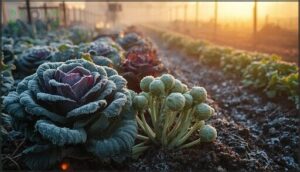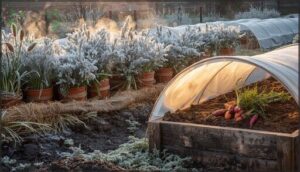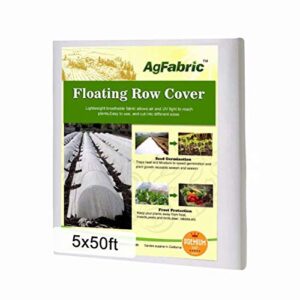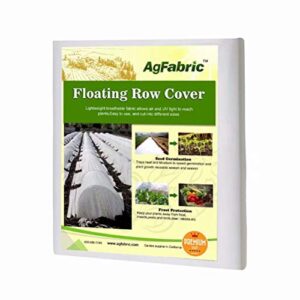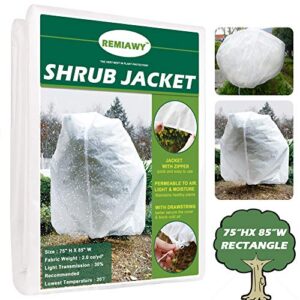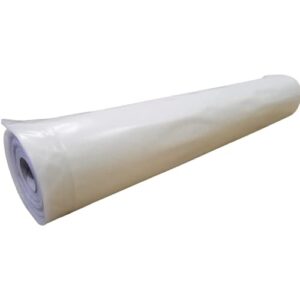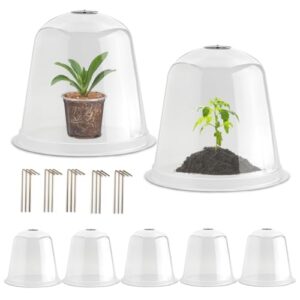This site is supported by our readers. We may earn a commission, at no cost to you, if you purchase through links.
A single night below 32°F can turn a thriving garden into a scene of wilted greens and blackened tomato stems. Most gardeners learn this lesson the hard way—stepping outside after an unexpected cold snap to find weeks of careful work undone.
The good news is that frost damage isn’t inevitable. When you understand what triggers cold injury and apply organic methods for frost protection in vegetables, you can extend your harvest by weeks or even months.
Simple techniques like row covers, mulching, and strategic watering work with nature’s own insulation principles to shield your crops. Whether you’re growing tender lettuce or hardy root vegetables, the right protection at the right time makes the difference between loss and abundance.
Table Of Contents
- Key Takeaways
- What Temperatures Cause Frost Damage in Vegetables
- Choosing and Preparing Frost-Tolerant Vegetables
- Organic Frost Protection Methods for Garden Beds
- Protecting Container and Root Vegetables From Frost
- Top 7 Organic Frost Protection Products for Vegetables
- 1. Agfabric Plant Covers Freeze Protection Blanket
- 2. Agfabric Plant Freeze Protection Row Cover
- 3. Remiawy Plant Cover Freeze Protection Blanket
- 4. Clear Greenhouse Plastic Sheeting Film Cover
- 5. RooTrimmer 13 Inch Garden Cloches
- 6. Year Round Vegetable Gardening Guide
- Agfabric Plant Covers Freeze Protection Blanket (duplicate for Completeness)
- Frequently Asked Questions (FAQs)
- Conclusion
Key Takeaways
- Most vegetables suffer damage at 32°F or below, but frost protection success depends more on how long plants stay frozen than the lowest temperature reached, with factors like soil moisture, cover materials, and microclimate positioning determining survival.
- Simple organic barriers like row covers, mulch layers 2-4 inches deep, and cold frames can raise plant temperatures by 2-8°F overnight, often providing enough protection to extend harvests by weeks without synthetic chemicals or electricity.
- Watering garden beds thoroughly by midday before frost arrives allows moist soil to release stored heat throughout the night, creating a natural buffer that delays freezing and protects root zones more effectively than dry ground.
- Selecting frost-tolerant varieties like kale and collards, hardening off seedlings gradually before planting, and timing crops around your region’s first and last frost dates prevents damage before it starts rather than scrambling to protect vulnerable plants.
What Temperatures Cause Frost Damage in Vegetables
Frost can sneak up on your garden when the temperature dips lower than you expect. Each vegetable reacts to the cold a little differently, and a few degrees can make all the difference between healthy plants and damaged leaves.
Let’s look at what to watch for when colder nights are in the forecast.
Identifying Frost Risk Temperatures
Cold snaps can sneak up fast, so it’s important to know your garden’s thresholds. Critical Temperatures for vegetable damage often start at 32°F, but Microclimate Effects—like low spots or proximity to shelter—can shift those numbers.
NOAA Data helps predict frost advisory and freeze warnings, yet overnight temperatures, humidity influence, and frost duration always tip the scales.
Different vegetables have varying levels of susceptibility to freezing.
Signs of Frost Damage in Tender Vs. Hardy Crops
You’ll spot frost damage in your vegetables by keeping an eye out for certain Tender Crop Signs—look for water-soaked, limp, or browned plant tissue in crops like tomatoes and beans. Hardy Crop Signs are less dramatic, often just wilted or darkened leaf edges in kale or spinach.
Hard frosts can damage plants severely. Cellular Level Damage in tender plants means quick wilting and little Post-Frost Recovery, especially when quality indicators, like texture and smell, drop.
How Duration and Microclimates Affect Frost Impact
Sometimes, it isn’t just how low the thermometer drops but how long your crops stand in the cold. The Exposure Duration—the stretch your plants spend below freezing—can decide if leaf edges simply brown or if whole stems turn to mush.
Frost damage depends less on how cold it gets and more on how long your plants stay frozen
Microclimate Effects, such as warmth radiating from soil insulation or protective covers, can make all the difference in backyard frost protection.
Choosing and Preparing Frost-Tolerant Vegetables
Regarding frost, some vegetables can roll with the punches better than others. Choosing the right varieties and getting them ready for cooler nights can make all the difference.
Here’s what you should think about as you plan for a resilient garden this season.
Selecting Hardy and Semi-Hardy Vegetable Varieties
Curious which FrostTolerant Vegetables can shrug off icy nights? Your choice depends on crop hardiness, region, and even Genetic Traits. Hardy plants like kale and collards excel in colder Hardiness Zones, while timing matters for root crops. Notice these success factors:
- Match varieties to your Regional Adaptation
- Favor hardy annual vegetable plants
- Use planting time for best survival
- Leverage Microclimate Impact
Hardening Off Seedlings for Cold Weather
Once outdoor temperatures reach the right threshold—usually 45–50°F—you’ll start hardening off your seedlings. Use gradual exposure: place them outside for short, sheltered stretches, avoiding harsh wind and bright light at first.
This acclimation improves survival, especially for tender plants. Hardy types develop stronger stems, thicker leaves, and better frost protection through these organic methods, thanks in part to underlying genetic effects.
Planning Planting Dates to Avoid Early Frost
A reliable harvest starts by understanding frost dates and using historical climate data. Build a planting strategy around your region’s last spring frost date and the first fall frost date, factoring in crop maturity timing and microclimate considerations.
Adding planting buffer weeks helps avoid frost surprises. This way, you’ll match your vegetables’ safety window and get the most from every season.
Organic Frost Protection Methods for Garden Beds
Keeping your vegetable garden safe from frost involves a few tried-and-true methods you can use right in your beds. Each has its own place in your toolbox, depending on the weather and what you’re growing.
Here are some of the most effective ways to protect your plants when the temperature drops.
Using Row Covers, Blankets, and Cloches
Think of row covers, blankets, and cloches as your garden’s first line of defense. Floating row covers and breathable blankets shield plants from frost, but the real trick lies in your cover material choices and good installation best practices.
Crop-specific covers offer targeted protection, while venting prevents heat buildup—especially for tomatoes and peppers—ensuring your vegetables stay safe, snug, and thriving.
Applying Organic Mulch and Compost for Insulation
Mulch acts like a blanket for your soil, helping roots stay warm when frost hits. Aim for a mulch depth of 2–4 inches using materials like straw, leaves, or wood chips to trap insulating air.
Compost applications—about 2–3 inches—further stabilize temperature, boost organic matter, and improve soil health.
Mulching practices like these deliver strong frost defense and healthier vegetables.
Building and Utilizing Cold Frames and Hoop Tunnels
Cold frames and hoop tunnels create mini-greenhouses that lift nighttime temperatures 10–20°F higher than outside air. Cold frame design using clear polyethylene or rigid panels and careful material selection protect crops like lettuce and kale.
Proper tunnel ventilation needs attention—open covers when sunny to prevent overheating, then close at dusk. These structures excel at protecting plants from frost while supporting organic gardening and strategic crop rotation.
Strategic Watering and Irrigation for Frost Defense
Watering before sunset warms soil from within—moist ground releases stored heat throughout the night and delays freezing. Water your garden beds by midday when frost threatens, applying enough moisture to dampen soil 6 inches deep. This irrigation timing creates a protective buffer that keeps roots stable.
Sprinkler systems running continuously through frost periods release latent heat, reducing crop damage while supporting your freeze protection strategy economically.
Protecting Container and Root Vegetables From Frost
Container plants and root vegetables need special attention when frost threatens because they’re more exposed to temperature swings than in-ground crops. Containers lose heat quickly through their sides, and root crops left in the soil can suffer damage if frost penetrates too deep.
Here’s how to protect both types of plants using simple, organic methods.
Moving and Insulating Potted Plants
When frost looms, protecting potted plants means quick action. Larger containers hold warmth longer, but every pot benefits from insulation materials—think frost cloths or wrapping with organic mulch.
Move your containers closer together, or tuck them beside a wall for extra shelter. Water thoroughly before a freeze, and try burying pots up to the rim for maximum damage reduction.
Mulching and Covering Root Crops
Once your potted plants are safe, turn your focus to root crops. A generous mulch depth—around 6 to 12 inches—keeps soil temperature steady, sheltering carrots or beets from harsh swings. Cover integration is simple: lay organic mulch, then stretch a row cover above. Besides blocking cold, these mulch benefits also feed the soil and prevent winter erosion.
- Feel confident your buried harvest will last
- Watch resilient greens emerge from snug beds
- Trust organic materials to feed both roots and earth
Top 7 Organic Frost Protection Products for Vegetables
If you want to shield your vegetables from harsh, unpredictable frosts, using the right products can make all the difference.
Below, you’ll find some of the best organic options designed to protect your garden through cold snaps and changing weather. Each one has its own strengths, suited for different needs in your vegetable patch.
1. Agfabric Plant Covers Freeze Protection Blanket
A good blanket can make all the difference for frost protection in your organic garden. The Agfabric Plant Covers Freeze Protection Blanket combines light, breathable spun fabric with strong reusability—lasting across several seasons if handled with care.
Its temperature protection boosts warmth under the cover by up to 8°F over ambient air, helping your vegetables extend their harvest.
With flexible coverage dimensions, this method is practical for varying bed sizes. The material properties also let in sunlight and moisture, supporting healthy growth.
Best For: Home gardeners and small-scale growers who need an easy, budget-friendly way to protect plants from frost, hail, snow, or birds during late fall and early spring.
- Lightweight, breathable fabric allows light and moisture through, so plants keep growing.
- Easy to cut and install, fits most garden beds or can be doubled up for more protection.
- Reusable and UV stabilized, giving multiple seasons of use if handled gently.
- Tears easily, especially on sharp edges or if handled roughly.
- Limited durability in harsh weather, with some reports of covers only lasting one season.
- May not provide enough protection for severe, prolonged freezes or high winds.
2. Agfabric Plant Freeze Protection Row Cover
Row covers take the practical principles from blankets a step further. The Agfabric Plant Freeze Protection Row Cover is a heavyweight spunbonded polypropylene option that delivers frost protection down to 24–28°F while allowing 70–85% light transmission for photosynthesis.
Material specifications include weights ranging from 0.45 to 2.0 oz./sq. yd., with heavier fabrics offering stronger frost efficacy. You can secure this breathable cover with soil, bricks, or garden staples—installation tips that prevent wind displacement while blocking pests like aphids and beetles. It’s reusable across multiple seasons when stored properly.
Best For: Gardeners who need reliable frost protection for vegetables and flowers while maintaining healthy airflow and light transmission through multiple growing seasons.
- Protects plants down to 24–28°F while still letting 70–85% of sunlight through for photosynthesis
- Blocks pests like aphids, beetles, and even small animals without chemical treatments
- Reusable for multiple seasons when stored properly, making it cost-effective long-term
- Can tear around sharp edges or stakes if you’re not careful during installation
- Needs to be removed on warm days (above 55°F) to prevent overheating and allow pollinators in
- Thinner weight options may not hold up as well to repeated use or harsh weather
3. Remiawy Plant Cover Freeze Protection Blanket
The Remiawy Plant Cover Freeze Protection Blanket offers adaptable frost protection methods through its breathable nonwoven fabric design. Sized from 8×24 ft to 10×33 ft, this medium-weight row cover provides approximately 2–4°F temperature lift—enough to shield cool-season vegetables during light frost events near 32°F.
Material permeability allows water and sunlight through while blocking pests, supporting organic IPM strategies in vegetable gardening. You can float it directly on plants or drape over hoops, securing edges with soil or stakes.
Usage limitations appear when temperatures drop into the mid-20s°F, where mulch layering becomes essential.
Best For: Home gardeners protecting cool-season vegetables and seedlings from light frost in temperate climates who want a reusable, pest-blocking alternative to chemical treatments.
- Breathable fabric lets water and sunlight through while providing 2–4°F temperature lift during light frosts near 32°F
- Works as a physical pest barrier for organic gardening, reducing need for pesticides against flea beetles, aphids, and cabbage moths
- Reusable across multiple seasons when stored properly, offering better value than single-use plastic covers
- Limited protection in severe cold (mid-20s°F or below) without additional insulation like mulch or layered covers
- Requires daily management—you’ll need to remove or vent during sunny days to prevent overheating plants underneath
- Fabric degrades over time from UV exposure and repeated folding, eventually reducing effectiveness and requiring replacement
4. Clear Greenhouse Plastic Sheeting Film Cover
Clear greenhouse plastic sheeting transforms hoop tunnels and cold frames into effective frost protection structures for vegetable gardening. Premium 6 mil polyethylene film with UV stabilization delivers 70–90% light transmission while adding 2–4°F thermal insulation—critical when temperatures hover near freezing.
Material durability reaches four years outdoors, resisting tears and UV breakdown. You can secure the plastic over hoops, sealing edges with soil or clips to trap heat.
Pairing this cover with organic mulch at the base creates a layered defense against hard frost events.
Best For: Gardeners who need reliable season extension or frost protection on hoop houses and cold frames without breaking the bank on heating costs.
- Lets through 70–90% of natural light so your vegetables can actually photosynthesize through winter instead of just sitting there in the dark.
- Four-year UV resistance means you’re not replacing this thing every season—it holds up through sun, wind, and temperature swings.
- Adds 2–4°F of insulation on its own, which can be the difference between a light frost nipping your greens and them sailing through unscathed.
- Single-layer R-value of 0.85 isn’t much—you might still need row covers, mulch, or a second layer if you’re dealing with serious cold snaps.
- Size accuracy can be hit-or-miss, so measure twice and be ready to improvise during installation if it doesn’t quite match your frame.
- Heavy snow or wild windstorms can test its limits, especially if you don’t have a sturdy frame or proper anchoring.
5. RooTrimmer 13 Inch Garden Cloches
Individual cloches offer a smart approach to frost protection when you need precise microclimate control for specific vegetables. The RooTrimmer 13 Inch Garden Cloches deliver 2–3°C temperature buffering, shielding tomatoes, peppers, and brassicas from overnight dips below freezing.
Clear plastic transmits 99.9% of sunlight, while the adjustable vents prevent humidity buildup that encourages disease.
These reusable units last 3–5 seasons, provide pest and wind defense, and extend your harvest window by 7–14 days—making them a cost-effective choice for protecting individual plants during unpredictable spring and fall frosts.
Best For: Gardeners who need targeted frost protection for individual vegetable plants like tomatoes, peppers, and leafy greens during unpredictable spring and fall temperature swings.
- Extends your growing season by 1–2 weeks in both directions with 2–3°C of frost protection, letting you start earlier and harvest longer
- Crystal-clear plastic lets nearly all sunlight through while blocking wind, pests, and light frost—plus it lasts 3–5 seasons with proper care
- Built-in vents let you control humidity so plants don’t get too damp, and the lightweight design makes them easy to move around your garden
- Some buyers received cracked or damaged units, suggesting inconsistent quality control during shipping
- You’ll need to buy stakes separately since they don’t come included, which adds to the total cost and setup time
- The 12-inch height works for seedlings and young plants but won’t cover larger or mature vegetables without modification
6. Year Round Vegetable Gardening Guide
Extending your harvest season beyond frost means blending knowledge with action—succession planting, microclimate design, hardy varieties, and proven watering techniques all come together in Year Round Vegetable Gardening.
This guide shows you how to build soil health and frost resistance using organic matter while protecting cool-season vegetables through strategic timing and winter gardening structures.
You’ll learn the material efficacy of row covers, cold frames, and mulches to keep spinach, kale, and carrots productive even when temperatures drop, turning your garden into a reliable four-season food source.
Best For: Gardeners in cold climates who want to grow fresh vegetables year-round using season extension techniques like cold frames, row covers, and succession planting.
- Shows you how to harvest 10 separate crops per year through succession planting and smart timing, with techniques that can boost greenhouse yields by 30% in cold zones.
- Gives you practical frost protection methods—row covers cut frost damage by 70%, and simple watering before a freeze can protect seedlings for up to 10 hours.
- Focuses on hardy varieties like kale, spinach, and carrots that actually thrive in cold weather, with detailed advice on building low-cost structures to extend your season by 4–8 weeks.
- Draws heavily from the author’s Nova Scotia experience, so you’ll need to adapt some techniques if you’re gardening in a different climate or zone.
- May feel too basic for advanced gardeners looking for highly technical or specialized growing information beyond season extension basics.
- The layout can be confusing to navigate, and at 256 pages, finding specific advice quickly isn’t always straightforward.
Agfabric Plant Covers Freeze Protection Blanket (duplicate for Completeness)
If you need multi-season frost protection, this Agfabric blanket delivers proven material durability and temperature elevation up to 6°F. Its UV-stabilized spun polypropylene withstands repeated freeze-thaw cycles while offering 70% light transmission for healthy growth.
Application techniques are simple—secure edges with stakes or organic matter. Though slightly pricier than basic row covers, cost analysis shows up to 125% ROI protecting tender plants through extended harvests.
Frequently Asked Questions (FAQs)
Can frost protection fabrics be reused multiple seasons?
Most polypropylene row covers last 2-4 seasons when properly maintained. Cleaning frost protection fabrics between uses can extend their lifespan by 5 years, while maintaining 80-90% effectiveness after repeated use.
How does wind affect frost formation overnight?
Wind affects frost formation by influencing temperature through the Wind Chill Factor and Evaporative Cooling. Calm nights below 2 mph intensify freeze protection needs, while wind speed above 5 mph reduces irrigation effectiveness and alters microclimates substantially.
Do organic fertilizers improve natural cold tolerance?
Like a warm coat on a cold morning, organic fertilizers boost cold hardiness by enriching the soil microbiome and improving nutrient uptake.
Research shows organic gardening techniques improve frost resistance through better microbial mechanisms and soil health.
When should frost protection be removed daily?
Remove frost protection once morning temperatures rise above 32°F. Check weather forecasts and lift covers by mid-morning to prevent humidity buildup and overheating, allowing your vegetables proper air circulation and sunlight exposure.
Are certain mulch materials better for frost?
Yes, clean straw and bark mulches excel at frost protection. Straw insulation keeps root zones 2–4°F warmer, while bark stability buffers temperature swings.
Rice straw and organic matter also help with moisture retention and garden insulation.
Conclusion
A single degree can mean the difference between harvest and heartbreak. With the organic methods frost protection vegetables offer—from row covers to strategic mulching—you’re not gambling on luck. You’re working with nature’s rhythm, wrapping your crops in warmth when the cold arrives.
Start small. Cover what matters most tonight. Then expand your defenses as the season demands. Your garden doesn’t have to surrender to frost. It just needs a little help holding on.
- https://pubs.nmsu.edu/_h/H251/
- https://extension.umd.edu/resource/row-covers
- https://www.canr.msu.edu/news/freeze_damage_in_fall_vegetables_identifying_and_preventing
- https://www.thrivelot.com/resources/how-microclimates-and-thermal-mass-work-together
- https://www.growveg.com/guides/how-to-prepare-your-garden-for-winter-frosts/


